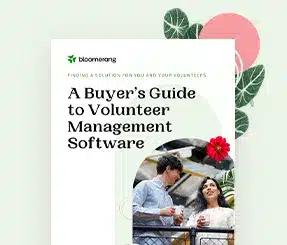8 Best Nonprofit Credit Card Processing Options in 2025


Full Platform Overview Chat With Us



Full Platform Overview Chat With Us




Leveraging a secure payment solution throughout the donation process strengthens donor trust and provides supporters with a convenient payment method. Credit card payments are donors’ preferred giving methods—63% of donors prefer to give online with a credit or debit card, followed by direct mail (16%), PayPal (10%), wire transfer (5%), cash (4%), digital wallet (1%), and text-to-give (1%).
In this guide, we’ll review the top credit card processing solutions for nonprofits and best practices for choosing the right platform. We’ll cover:
Nonprofit credit card processing solutions are tools nonprofit organizations use to complete credit and debit card transactions quickly and in compliance with donation processing standards. They encrypt sensitive financial data and ensure that payments are securely transmitted from donors’ accounts to the organization’s account.
A powerful payment processor allows nonprofits to collect funds quickly, easily, and securely. These tools make it easy to start using donated funds as soon as possible to keep your mission moving forward.
Choosing the right payment platform can also help build trust with supporters. The 2024 Give.org Donor Trust Report found that 67% of donors say it’s important to trust a nonprofit organization before giving. However, only 22% highly trust charities.
By leveraging a secure payment processor that protects donors’ information, you can reassure supporters that your organization is a responsible steward of their gifts.
These platforms can manage a wide range of transactions, including:
Many platforms also offer modern payment methods like donor-advised funds, cryptocurrency, and Venmo.
Yes, and it’s important to understand how payment processing fees work so you can find the right solution that fits your budget and generates the highest return on your investment.
Here is some terminology that you might see when exploring payment processing costs:
When choosing the right platform for your nonprofit, calculate the effective rate for each option by dividing total fees by total expected donations. This can give you an idea of how much you will pay for each platform.
Additionally, many payment platforms offer discounts for nonprofits or other ways to reduce costs, such as enabling donors to cover processing fees. Look into these benefits as you compare top options.
Often, yes. If you’re interested in using a payment processor that’s not specifically built for nonprofits, like PayPal or Stripe, look into fee discounts and other perks available to nonprofits.
In addition to monthly or transaction fees, some payment processors may come with extra fees that aren’t included in the initial pricing information. Look out for additional fees like:
Depending on your nonprofit’s budget, these fees may add up over time and reduce your ROI. Be thorough with your questions in each demo to ensure you fully understand each platform’s fee structure and choose the best solution for your fundraising efforts.
It depends on the payment processing system. Typically, platforms make funds available in one to three business days. Some platforms may offer same-day or instant payment transfers for an extra fee, which can come in handy in times of urgent need.
| Top Features | Payment Methods | Payout Timeline | Pricing | |
| Bloomerang Payments |
|
Google Pay, Apple Pay, credit/debit cards, ACH, and in-person donations | Flexible payout schedules that your organization can fully control | A processing fee of 2.2% + $0.30 per transaction and a 1% fundraising platform fee (can be covered by donors) |
| Stripe | Access to over 100 payment methods and global reach | Credit/debit cards, Apple Pay, Afterpay, PayPal, Google Pay, and more | Daily automatic | Nonprofit rate of 2.2% + $0.30 transaction fee per transaction |
| Square | Automatic sorting of donors into a segmented directory | Cash, checks, ACH bank transfers, credit/debit cards, swipe or chip cards, and contactless NFC payments like Apple Pay and Google Pay | 1-2 business days | 2.9% + 30¢ per transaction |
| PayPal | Donate button for your nonprofit’s website | Major credit/debit cards, PayPal, and Venmo | 2-3 business days | Discounted rate for charities of 2.89% and a fixed fee |
| Authorize.Net | Automatic, monthly credit card updates | Credit/debit cards, PayPal, Apple Pay, and eCheck | 2-3 business days | Monthly gateway is $25 with a 2.9% and $0.30 transaction fee |
| Clover | Point-to-point encryption, tokenization, and EMV | Cash, checks, credit/debit cards, Apple Pay, Google Pay, and Samsung Pay | 1-3 business days | Rates start at 2.3% + $0.10 per transaction |
| KeelaPay | In-house support contained in one service | Visa, Mastercard, American Express, and ACH | Customizable disbursements; payments can be withdrawn nightly, weekly, or monthly | Uses Stripe and PayPal to process donations; transaction fees of 2.2% + $0.30 |
| Dharma Merchant Services | eCommerce integration | Credit cards | 2 business days | $15 per month fee, processing fees of 0.10% + $0.08 for storefront payments, and 0.10% + $0.11 for virtual payments |
Best for: Nonprofits that want to leverage a secure payment processor integrated with their Bloomerang CRM and online fundraising tools.
Top Features:
Bloomerang is the top integrated payment processing option for nonprofits that want to protect donor information, leverage donor data for future campaigns, and accept and deposit payments all in one place.
Other payment processors integrate with Stripe and PayPal, so nonprofits may not be able to access nonprofit-specific giving methods and may be charged additional fees. Bloomerang Payments is built on top of Stripe, allowing for customization to suit your nonprofit’s needs.
One of the greatest benefits of the Bloomerang Payments system is its industry-leading fraud management and protection. Fraud management is included in the system, so nonprofits aren’t charged extra for this service. Bloomerang Payments is PCI-compliant, and we prioritize donor data protection.
Here are a few additional features that make Bloomerang Payments a top option for nonprofits:
In addition, tap-to-pay is an exciting new feature within Bloomerang Payments. With this functionality, donors can tap their credit card, Apple Pay, or Google Pay digital wallet onto a mobile device and have their gift processed through the Bloomerang mobile app. Tap-to-pay creates a speedy in-person donation process and doesn’t require any specialized card readers.
Additional Payment Methods Accepted: Google Pay, Apple Pay, debit, credit, ACH, in-person donations
Payout Timeline: Bloomerang Payments provides flexible payout schedules that your organization can fully control
Pricing: Bloomerang offers among the most competitive rates in the payment processing field, with a processing fee of 2.2% + $0.30 per transaction. The ACH fee is 0.8% + $0.30 per transaction. There is also a 1% fundraising platform fee on all transactions processed through Bloomerang. Processing fees apply to the total transaction volume and include the optional donor-covered fee. However, Bloomerang allows donors to choose to cover processing fees.
Tool for: Nonprofits looking to easily accept global payments and access instant payouts if needed.
Top Features:
Payment Methods: Credit/debit cards, Apple Pay, Afterpay, PayPal, Google Pay, and many more
Payout Timeline: Daily automatic
Pricing: Nonprofit rate of 2.2% + $0.30 transaction fee per transaction
Tool for: Nonprofits looking to manage point of sale and online transactions.
Top Features:
Payment Methods: Cash, checks, ACH bank transfers, credit/debit cards, swipe or chip cards, and contactless NFC payments like Apple Pay and Google Pay.
Payout Timeline: 1-2 business days
Pricing:2.9% + 30¢ per transaction
Tool for: Nonprofits looking for a payment processor that prioritizes digital conversions.
Top Features:
Payment Methods: Major credit cards, debit cards, PayPal, and Venmo
Payout Timeline: Two to three business days
Pricing: Discounted rate for charities of 2.89% and a fixed fee
Tool for: Nonprofits looking for a wide variety of payment types to offer donors, from eCommerce to eCheck, point of sale, mobile payments, and more.
Top Features:
Payment Methods: Credit/debit cards, PayPal, Apple Pay, eCheck
Payout Timeline: 2-3 business days
Pricing: Monthly gateway is $25 with a 2.9% and $0.30 transaction fee
Tool for: Nonprofits looking to accept donations via multiple giving methods, including POS, mobile, and desktop
Top Features:
Payment Methods: Cash, checks, credit cards, debit cards, Apple Pay, Google Pay, Samsung Pay
Payout Timeline: 1-3 business days
Pricing: Rates start at 2.3% + $0.10 per transaction
Tool for: Nonprofits looking for a payment processing system that integrates with the Keela CRM and fundraising tools.
Top Features:
Payment Methods: Visa, Mastercard, American Express, ACH
Payout Timeline: Customizable disbursements; payments can be withdrawn nightly, weekly, or monthly.
Pricing: Uses Stripe and PayPal to process donations; transaction fees of 2.2% + $0.30
Tool for: Nonprofits looking to simplify payments while keeping costs low.
Top Features:
Payment Methods: Credit cards
Payout Timeline: 2 business days
Pricing: $15 per month fee, processing fees of 0.10% + $0.08 for storefront payments, and 0.10% + $0.11 for virtual payments
How can you determine which of these payment processors is right for your nonprofit? Follow these steps to narrow down your top options and choose the best system for long-term growth.
Often, choosing the right payment processor comes down to your nonprofit’s size. That’s because some fee structures work better for different-sized organizations. Here’s a breakdown of the structures that work best for large and small nonprofits:
Carefully assess your nonprofit’s needs and compare fee structures to find the right fit for your fundraising efforts.
Leveraging a payment processor that integrates with your other software solutions makes it easier to gather donor data and use it in future transactions. Plus, when your payment processor is visually similar to your online donation form and branded to your organization, you can reassure donors that they’re giving to the right organization.
Search for a payment processor that integrates with software tools like your:
These integrations will ensure seamless, secure data transfers and simplify your fundraising process.
Your payment processor can do much more than just manage financial transactions. Advanced systems, especially those built specifically for nonprofits, offer additional features to increase revenue and improve the payment experience. Look for features such as:
Determine whether these features are built into the platform or if they’re available for an additional fee.
A secure payment process is critical to keep donor information safe, build trust, and inspire repeat donations. Make sure the payment process you choose offers security measures like:
Request a demo for each of your top options and ask each representative to walk through their system’s security credentials. Ask plenty of questions to make sure you feel comfortable with your final choice.
Your payment processing platform should offer access to an experienced support team that can answer your questions promptly. This is necessary to quickly address and resolve any payment issues and maintain donor satisfaction and trust.
The support team should be available via live chat, phone, or email and provide a wide variety of support services to handle different needs. For example, Bloomerang’s support team provides implementation and onboarding support, coaching, and consulting services based on the level of support you require.
Use third-party software review aggregators to get insight from real customers. Search for your top payment processing options on platforms like G2 and Capterra. These resources will provide an unbiased look at each payment processor and insights into what customers like or dislike about the systems.
Offering a variety of payment methods beyond credit card processing is essential to appealing to different generational preferences.
According to Nonprofit Tech for Good, these are the preferred giving methods of each generation:
Offering in-person, direct mail, and online payment methods is important to connect with all generations. When determining what payment processor to invest in, find a solution that aligns with your supporters’ preferences.
Consult with your nonprofit’s fundraising team to gather their input and make your final payment processing decision. Gathering feedback from fundraising team members will help you choose a platform that works best for your unique donor base. Plus, they’ll be able to provide insight into which options work best based on your donors’ demographics and giving preferences.
Careful research is required to find the right credit card processing option that will support your nonprofit’s long-term goals. If you need more support to find the right choice and understand how payment processing works in a fundraising context, start with these additional resources:

Comments